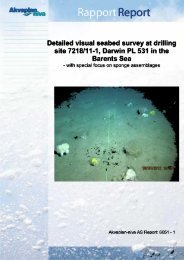A study of the priority substances of the Water Framework Directive ...
A study of the priority substances of the Water Framework Directive ...
A study of the priority substances of the Water Framework Directive ...
Create successful ePaper yourself
Turn your PDF publications into a flip-book with our unique Google optimized e-Paper software.
� There are several PAHs, <strong>of</strong> which approx. 15<br />
are considered human carcinogens.<br />
� Many PAHs are persistent and bioaccumulate.<br />
� Three PAHs are WFD Priority Substances.<br />
� No fur<strong>the</strong>r PAH screening is considered necessary<br />
in Norway, but monitoring should continue,<br />
as levels are quite high on several locations.<br />
� See also fact sheets 2, 14 and 22 for some<br />
specific PAHs<br />
Production and use<br />
PAHs are mainly formed from incomplete combustion.<br />
Several PAHs are used as intermediates,<br />
such as naphthalene, acenaph<strong>the</strong>ne, anthracene,<br />
fluorine, fluoran<strong>the</strong>ne, phenanthrene, and<br />
pyrene. These are used in polymers, dyes, pigments,<br />
surfactants, dispersant's, tanning agents,<br />
solvents, insecticides, resins and rubber s<strong>of</strong>teners.<br />
In Norway <strong>the</strong> historic practice <strong>of</strong> using woodtar<br />
as wood preservative on buildings and boats<br />
is still widespread. Creosote is still in use as<br />
wood preservative, but with restrictions for use.<br />
Creosote can contain up to 85 % PAH<br />
(CIRCA). There are restrictions for levels <strong>of</strong> BaP<br />
in creosote.<br />
Emissions, discharges,<br />
distribution and hot-spots<br />
Emissions have been stable from 1995 to 2003<br />
at about 200 tons. Discharges to water have<br />
increased in <strong>the</strong> same period from 14 to 29 tons<br />
according to <strong>the</strong> SFT.<br />
Main emitters were metal producers (50 %),<br />
households (combustion) and wood preservation<br />
(creosote). Wood preservation has reduced<br />
emissions with about 30 % since 1995, but was<br />
still a large source in 2002.<br />
There are several hotspots for PAH, such as<br />
smelters, industrial sites and landfills (manganese,<br />
aluminium), sites where creosote has<br />
been or are being used, coke production and old<br />
gasworks. Emmissions to water from <strong>the</strong> Hydro<br />
aluminium smelter at Sunndalsøra (Møre and<br />
Romsdal County) has dropped significantly,<br />
from 0,6 tons to 0,04 tons in 2004. Emissions<br />
polyaromatic hydrocarbons (PAH) ::::::::::..<br />
28 Polyaromatic hydrocarbons (PAH)<br />
FACTS<br />
Cas no.: 130498-29-2<br />
Synonyms: Coal tar, Aromatic polycyclic hydrocarbons,<br />
Polyarenes.<br />
Properties: Differs, <strong>of</strong>ten needles with faint odour.<br />
Toxic effects: Many <strong>substances</strong> are probable carcinogens<br />
(approx. 15) and genotoxic.<br />
Benzo(a)pyrene is considered most toxic, it is carcinogenic,<br />
mutagenic, teratogenic and genotoxic.<br />
Many <strong>of</strong> <strong>the</strong> PAHs are toxic to aquatic organisms.<br />
Log Kow: In <strong>the</strong> range <strong>of</strong> 3 to 6<br />
Persistence: Half life for PAHs varies between <strong>substances</strong>.<br />
Half-lives in soil and sediments vary from<br />
days to several years depending on substance, climate,<br />
light etc. Half life in fresh water and marine<br />
environments varies from days to years, depending<br />
on substance and conditions. For many <strong>substances</strong><br />
volatilization from soil (dry/wet), water and hydrolysis<br />
are not important for environmental fate. Many PAHs<br />
accumulates in aquatic life forms.<br />
<strong>Water</strong> solubility: 1,6 to 3,8 µg/l at 25°C for<br />
benzo(a)pyrene<br />
Molecular formula: Multi-core aromatic ring systems.<br />
Metabolites: 20 primary and secondary oxidized<br />
metabolites and to a variety <strong>of</strong> conjugates. Several<br />
metabolites can induce mutations, transform cells<br />
and/or bind to cellular macromolecules, however<br />
only a 7,8-diol-9,10-epoxide is presently considered<br />
to be an ultimate carcinogenic metabolite (for<br />
B(a)P).<br />
from <strong>the</strong> aluminium smelter in Mosjøen<br />
(Nordland County) gas dropped from 2,5 tons<br />
to 0,04 tons in 2004 due to change <strong>of</strong> technology.<br />
Monitoring<br />
Monitoring <strong>of</strong> PAH has been part <strong>of</strong> JAMP and<br />
time trends exist here. PAH has also been investigated<br />
in several o<strong>the</strong>r studies (see references).<br />
Marine sediment<br />
Many Norwegian harbour and fjord sediments<br />
are strongly polluted by PAH. Most harbours<br />
are screened, as are all fjords with heavy industry.<br />
A <strong>study</strong> <strong>of</strong> <strong>the</strong> <strong>priority</strong> <strong>substances</strong> <strong>of</strong> <strong>the</strong> <strong>Water</strong> <strong>Framework</strong> <strong>Directive</strong><br />
TA-2140/2005<br />
67:::..

















